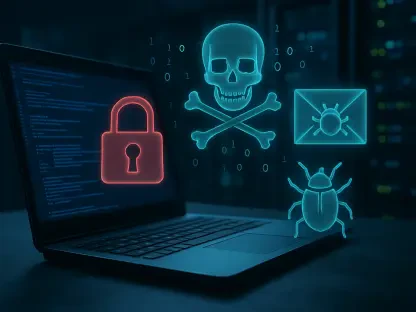As the world becomes increasingly interconnected, safeguarding critical infrastructure (CI) has become a vital aspect of national and international security. Essential systems such as energy grids, communication networks, financial services, healthcare, and transportation are integral to societal functioning. Yet, they are also vulnerable to cyberattacks that have grown in sophistication and scope. These cyber threats are no longer isolated incidents but are now orchestrated campaigns by both state and non-state actors. With the advent of technologies like artificial intelligence (AI), traditional cybersecurity measures are becoming less effective, necessitating more advanced and real-time defense mechanisms. This article delves into the various challenges faced in protecting CI and potential strategies for enhancing cybersecurity resilience.
Challenges in Defining Critical Infrastructure
Inconsistencies in Global Definitions
One of the foremost obstacles in protecting CI is the lack of a standardized definition across the globe. Different countries classify and prioritize diverse sectors under CI, leading to varied security protocols and protective measures. These variations can impede coordinated international efforts in combating cyber threats. For example, sectors considered critical in one nation may not receive the same prioritization or protection in another. This inconsistency was starkly highlighted during the 2017 NotPetya attack when the differences in CI definition led to delays in crisis response and mitigation strategies. To address this, there is a growing call for a more adaptable approach to defining CI, which reflects both current vulnerabilities and attack trends. A flexible framework that includes digital infrastructure, like data storage and processing systems, would establish common ground for international cooperation and crisis management.
Implications for International Collaboration
The variance in CI definitions also complicates international collaboration. While there is a consensus on applying existing international laws, such as the Geneva Conventions of 1949, to cyberspace, enforcement remains challenging. New international initiatives like the Global Digital Compact and the Open-ended Working Group aim to create norms that discourage cyberattacks on CI. These processes also emphasize fostering mutual aid among countries during cyber emergencies. Additionally, initiatives like public attribution of cyberattacks at international forums encourage deterrence and accountability. By adopting measures such as digital emblems that identify key online services as CI, countries can better signal the protected status of their infrastructures, thereby reducing their susceptibility to cyber threats.
Enhancing Public-Private Cybersecurity Partnerships
Leveraging Private Sector Expertise
The collaboration between public institutions and private entities is critical in fortifying CI against cyber threats. The private sector possesses significant expertise in threat detection and incident response, which can be integral to national cybersecurity strategies. Companies such as MasterCard illustrate this dynamic by employing generative AI to thwart cyberattacks and detect compromised data in financial networks. Governments can effectively augment their cybersecurity efforts by engaging with private organizations and integrating commercial technologies and insights. This approach not only broadens the scope of threat surveillance but also ensures prompt responses to emerging threats, ultimately fostering a resilient CI ecosystem.
Addressing Information Sharing Barriers
Despite the potential benefits of public-private partnerships, challenges in information sharing persist, often due to legal, regulatory, or commercial barriers. Many private sector entities are apprehensive about sharing critical threat information, fearing repercussions or loss of competitive advantage. However, creating a transparent framework that promotes open communication and data exchange can bridge this divide. By establishing clear protocols and trusted channels for information sharing, both public entities and private firms can contribute to a more comprehensive understanding of the cyber threat landscape. Such collaboration can lead to faster identification of vulnerabilities and more effective countermeasures, enhancing overall cybersecurity resilience.
Mitigating Supply Chain Vulnerabilities
Addressing Hardware Security Concerns
Supply chains continue to present significant cybersecurity challenges, especially regarding foreign-manufactured IT products used in CI. The lack of transparency in manufacturing processes often leaves users unaware of potential backdoors or compromised firmware, which could facilitate cyberattacks. This is particularly concerning with products sourced from countries with different cybersecurity standards, such as China. Establishing common international standards and certifications for product security can mitigate these risks. Collaborative efforts are crucial, with countries working together to ensure supply chain integrity by fostering domestic manufacturing capabilities and reducing reliance on potentially compromised foreign vendors.
Promoting Domestic Technological Development
Enhancing national cybersecurity also requires investing in indigenous intellectual property and domestic technology development. By focusing on local innovations, countries can build resilient systems less dependent on foreign solutions that might pose security risks. Experts suggest adopting zero-trust principles in hardware security, including continuous verification and authentication of devices, regular firmware assessments, and network segmentation to thwart potential breaches. These measures help build a formidable defense against an array of cyber threats while encouraging technological self-reliance, thus bolstering overall national security.
Rethinking International Cybersecurity Norms
The Role of Emerging International Frameworks
Efforts to revamp international cybersecurity norms are underway, aiming to provide a solid legal framework for protecting CI in cyberspace. However, the lack of enforcement mechanisms remains a challenge. The Global Digital Compact and the Open-ended Working Group are among the initiatives striving to establish binding international norms. These frameworks seek to enhance cooperation, discourage cyberattacks, promote joint threat assessments, and facilitate capacity-building initiatives. By establishing global benchmarks for acceptable state behavior in cyber operations, such frameworks encourage a collective resistance against cybercriminal activities.
Encouraging Multilateral Cooperation
Multilateral cooperation is deemed crucial in building a secure cyberspace. Efforts to adopt sanctions and coordinated responses through forums like the EU Cyber Diplomacy Toolbox exemplify such cooperation. By conducting public and private attributions of cyberattacks, countries can coordinate punitive measures against perpetrators, thus sending a strong deterrent message. Crafting partnerships with technology giants for intelligence sharing further contributes to this goal. Through collective actions, the global community can pave the way for a stronger, cohesive stance against cyber threats, safeguarding CI effectively.
A Collaborative Path Forward
The partnership between government bodies and private companies is essential for strengthening Critical Infrastructure (CI) against cyber threats. The private sector offers substantial expertise in detecting threats and responding to incidents, which can be vital to national cybersecurity plans. For instance, companies like MasterCard demonstrate the importance of this collaboration by using generative AI technology to prevent cyberattacks and identify compromised data within financial networks. The government can significantly enhance its cybersecurity efforts by collaborating with private organizations and utilizing commercial technologies and insights. This collaboration not only expands the reach and accuracy of threat detection but also ensures quick counteractions to new cyber threats, ultimately contributing to a robust and resilient CI environment. By merging the strengths of both sectors, the overarching aim is to establish a more secure infrastructure that can withstand an array of cyber challenges, ensuring both short-term safety and long-term security in an increasingly digital age.









